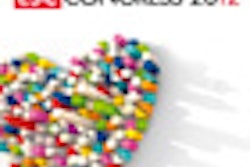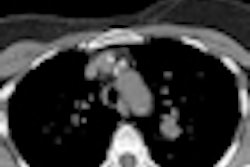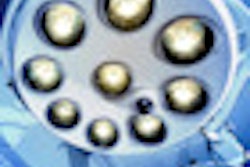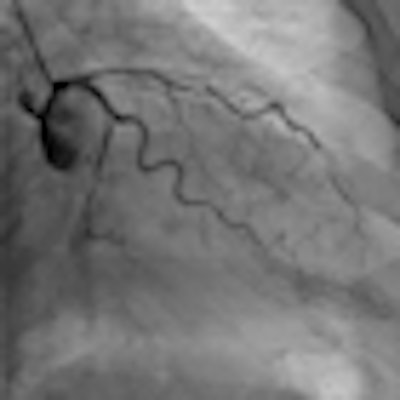
At the University Hospital of Ghent in Belgium, a new biplane cath lab is set to play a major role in pediatric and adult imaging. Because only limited contrast can be used in children, the facility's two flat-panel detectors will provide more images using only one contrast injection.
The cath lab will be used not so much for diagnosis in pediatrics but more for interventional techniques particularly pertaining to congenital heart defects, according to Dr. Yves Taeymans, head of the invasively interventional lab at University Hospital.
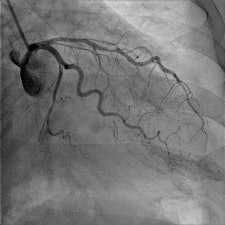
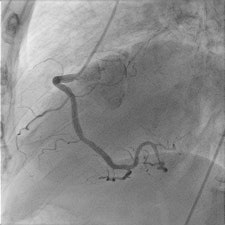 Images of the left and right coronaries taken on the AlluraClarity system, incorporating a 50% reduction in radiation dose. Images courtesy of Dr. Yves Taeymans.
Images of the left and right coronaries taken on the AlluraClarity system, incorporating a 50% reduction in radiation dose. Images courtesy of Dr. Yves Taeymans."Progress in medicine has seen the development of another kind of patient: Small children with congenital heart defects survive into adulthood and then develop arrhythmias or other linked problems such as valvular disease," he noted.
For this reason, this biplane lab will also be used for adults for a variety of complex electrophysiological interventions such as the treatment of arrhythmias, as well as aortic and pulmonary valvular interventions.
The main advantage for patients is a 50% reduction in total radiation dose through postprocessing of the images obtained by the flat-panel detectors. For one standard adult coronary angiogram, the typical dose used to be 6 to 7 mSv. Cardiologists at the Ghent lab are hoping they will be able to achieve 2 to 3 mSv.
 Dr. Yves Taeymans from Ghent. Image courtesy of Christophe Vander Eecken.
Dr. Yves Taeymans from Ghent. Image courtesy of Christophe Vander Eecken.
"Around 50% of the population's radiation in Belgium is due to medical applications. While not everyone will come to the lab, a reduction in x-ray dose will in the long run help improve radiation in the population," explained Taeymans, adding that the hospital's three labs are staffed by a total of 10 nurses, five interventional cardiologists, three pediatric cardiologists specializing in congenital heart diseases, and three electrophysiologists.
From conception to installation, the new lab in Ghent is the product of an 18-month project aimed at providing the hospital with a new generation of cath lab with 3D capabilities.
"3D images from CT or MRI superimposed on fluoro provide a road map of the aortic route making it easier to orientate and position the valve precisely for valve implantation." Taeymans said.
Funded by the university's own budget, the biplane lab, which replaces an existing monoplane lab, cost 1.8 million euros for all hardware and room adaptation. Staff so far has limited experience of the lab's capabilities and not all software has yet been used. However, easy-to-use controls and capacity to view multimodality images during procedures on one very wide screen make this, the biggest of Ghent's three cath labs, a state-of-the-art imaging room.
"The quality and innovation of the four main cath lab companies -- Siemens, Phillips, GE, and Toshiba -- are very close, but in our case we chose the Phillips AlluraClarity system due to its radiation dose reduction capabilities," Taeymans said.
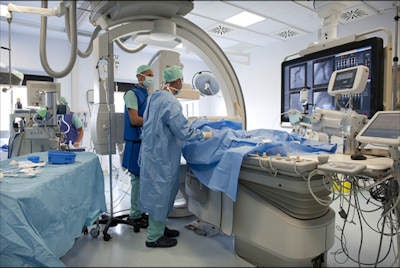 The new lab in Ghent is likely to see a shift toward complex procedures. Copyright: Thomas Verfaille.
The new lab in Ghent is likely to see a shift toward complex procedures. Copyright: Thomas Verfaille.In Belgium, coronary exams, reports, and interventions are predominantly performed by cardiologists, and in the new cath lab, turf is not an issue: Radiologists perform MRI and CT, and these images are sent to the lab where they are used in some procedures, he noted.
The three labs will continue to see a patient throughput of 35,000 per year, one-third of which will be procedures and two-thirds of which will be diagnostic, with a quarter of diagnoses sent to surgery.
"The new lab won't improve patient throughput numbers, but we will see more of a shift toward complex procedures which, while tending to be more time-consuming and expensive, will improve patient outcomes and probably save more lives," Taeymans said.




